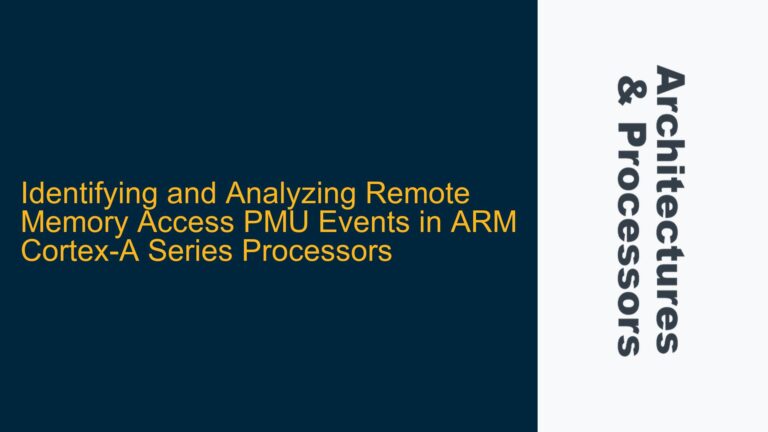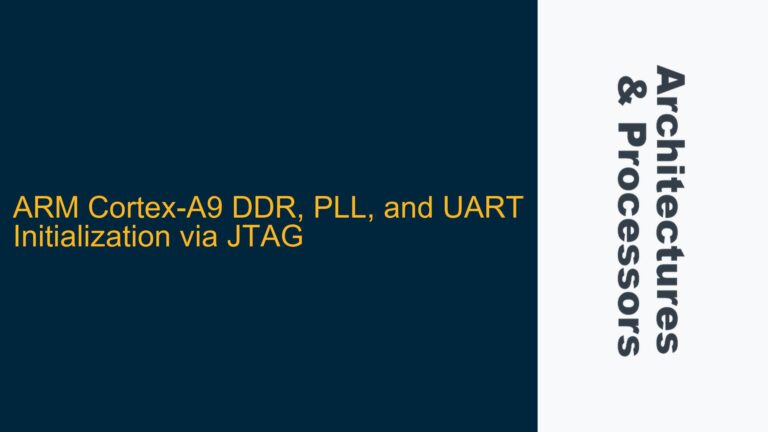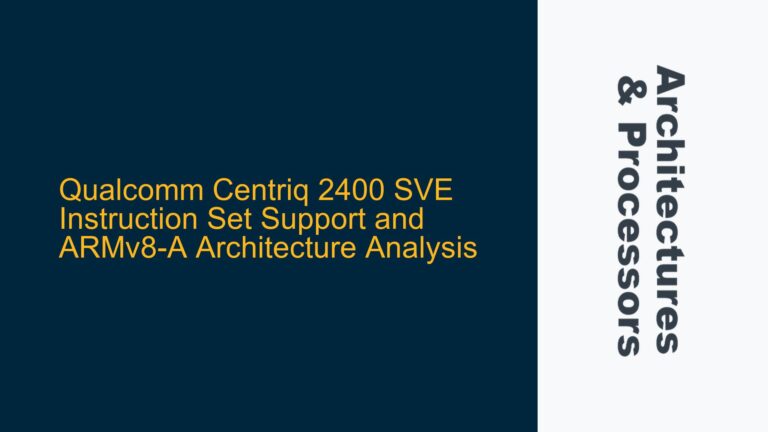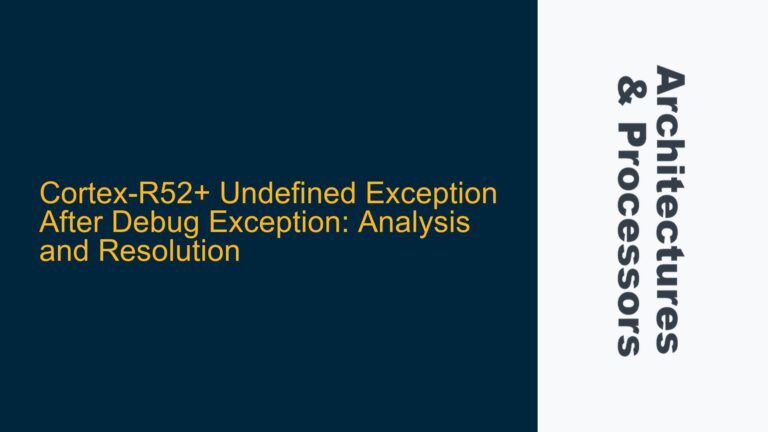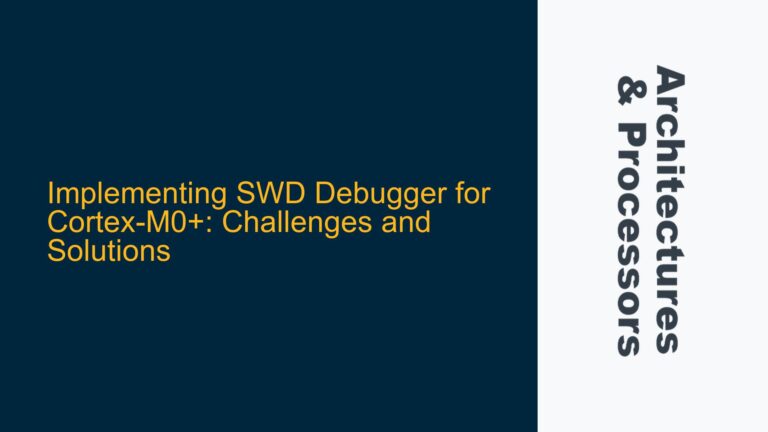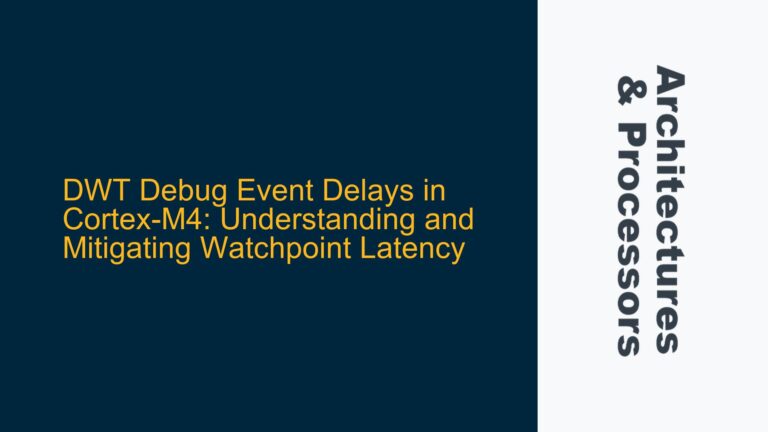ARM Cortex-A53 STP Instruction Memory Corruption on AHB Bus
The ARM Cortex-A53 processor, a widely used 64-bit core in embedded systems, is known for its efficiency and performance. However, subtle issues can arise when executing certain instructions under specific conditions. One such issue involves the STP (Store Pair) instruction, which is designed to store two 32-bit or 64-bit registers into memory. In this case, the STP instruction is causing memory corruption when accessing memory regions connected via the AHB (Advanced High-performance Bus) bus. This issue is particularly evident when the MMU (Memory Management Unit) is disabled, and the memory is marked as a Device type rather than Normal memory. The corruption manifests as unexpected writes to adjacent memory locations, which can lead to system instability or data integrity issues.
The core of the problem lies in the interaction between the Cortex-A53’s memory access behavior, the AHB bus protocol, and the memory attributes assigned to the target region. When the MMU is disabled, the memory attributes default to Device type, which imposes stricter access rules compared to Normal memory. Additionally, the AHB bus, being less complex than AXI (Advanced eXtensible Interface), may not handle certain memory access patterns as gracefully, especially when dealing with unaligned or non-standard access sizes. This combination of factors leads to the observed memory corruption.
To fully understand and resolve this issue, it is essential to delve into the specifics of the Cortex-A53’s memory access behavior, the differences between AXI and AHB buses, and the implications of memory attributes on instruction execution. By addressing these factors, we can identify the root cause and implement effective solutions to prevent memory corruption during STP instruction execution.
Memory Attributes, Bus Protocols, and STP Instruction Behavior
The Cortex-A53 processor’s memory access behavior is influenced by several factors, including memory attributes, bus protocols, and the alignment of memory addresses. When the MMU is disabled, the memory attributes default to Device type, which imposes stricter access rules compared to Normal memory. Device memory attributes are designed for peripherals and other memory-mapped I/O devices, where access patterns and timing are critical. These attributes include restrictions on access sizes, alignment, and reordering, which can affect how the STP instruction interacts with the memory subsystem.
The STP instruction is designed to store two registers into consecutive memory locations. In this case, the instruction STP W6, W6, [SP, #20] attempts to store the value of register W6 into the memory locations [SP + 20] and [SP + 24]. However, due to the combination of Device memory attributes and the AHB bus protocol, the instruction results in unexpected writes to adjacent memory locations, specifically [SP + 16] and [SP + 28]. This behavior is not observed when the memory is mapped as Normal memory or when the AXI bus is used.
The AHB bus, being a simpler protocol compared to AXI, has limitations in handling certain memory access patterns. For example, AHB does not support unaligned accesses as gracefully as AXI, and it may split single transactions into multiple smaller transactions, which can lead to unexpected behavior when combined with Device memory attributes. Additionally, the AHB bus may not handle the STP instruction’s dual-register store operation as efficiently, leading to corruption of adjacent memory locations.
The alignment of the stack pointer (SP) also plays a role in this issue. While the SP is 16-byte aligned in this case, the offset of 20 bytes results in an unaligned access relative to the 64-bit boundary. This misalignment, combined with the AHB bus’s limitations, exacerbates the memory corruption issue. When the memory is mapped as Normal memory or when the AXI bus is used, the Cortex-A53’s memory subsystem can handle the unaligned access more gracefully, preventing the corruption.
Resolving STP Instruction Memory Corruption on AHB Bus
To resolve the memory corruption issue caused by the STP instruction on the AHB bus, several steps can be taken. These include modifying memory attributes, adjusting the memory access pattern, and ensuring proper alignment of memory addresses. Each of these steps addresses a specific aspect of the issue and contributes to a stable and reliable system implementation.
Modifying Memory Attributes
The first step is to ensure that the memory region accessed by the STP instruction is mapped as Normal memory rather than Device memory. Normal memory attributes allow for more flexible access patterns, including unaligned accesses and larger transaction sizes, which are better suited for the STP instruction. This can be achieved by enabling the MMU and configuring the memory region with the appropriate attributes. If the MMU cannot be enabled, the memory region should be mapped as Normal memory in the system’s memory map.
Adjusting Memory Access Pattern
If modifying the memory attributes is not feasible, the memory access pattern can be adjusted to avoid the limitations of the AHB bus. This can be done by splitting the STP instruction into two separate STR (Store Register) instructions, each storing a single register to the target memory location. For example, the instruction STP W6, W6, [SP, #20] can be replaced with:
STR W6, [SP, #20]
STR W6, [SP, #24]
This approach ensures that each store operation is handled as a separate transaction, reducing the likelihood of memory corruption. While this may result in a slight performance penalty, it provides a reliable workaround for the issue.
Ensuring Proper Alignment
Ensuring that the memory addresses accessed by the STP instruction are properly aligned can also help prevent memory corruption. In this case, the stack pointer (SP) is 16-byte aligned, but the offset of 20 bytes results in an unaligned access relative to the 64-bit boundary. To address this, the offset can be adjusted to ensure that the target memory addresses are 64-bit aligned. For example, the instruction STP W6, W6, [SP, #16] would result in aligned accesses to [SP + 16] and [SP + 24], which are both 64-bit aligned.
Testing and Validation
After implementing the above steps, it is essential to thoroughly test and validate the system to ensure that the memory corruption issue has been resolved. This includes running the modified code under the same conditions as the original issue, verifying that the memory contents are correct after the STP instruction executes, and checking for any unexpected behavior. Additionally, the system should be tested with different memory configurations and bus protocols to ensure that the solution is robust and reliable.
Conclusion
The memory corruption issue caused by the STP instruction on the AHB bus is a complex problem that arises from the interaction between the Cortex-A53’s memory access behavior, the AHB bus protocol, and the memory attributes assigned to the target region. By modifying memory attributes, adjusting the memory access pattern, and ensuring proper alignment, the issue can be effectively resolved. These steps provide a reliable solution that ensures stable and predictable system behavior, even under challenging conditions.
Implementing Data Synchronization Barriers and Cache Management
In addition to the steps outlined above, implementing data synchronization barriers and proper cache management can further enhance system stability and prevent memory corruption. Data synchronization barriers ensure that memory accesses are completed in the correct order, preventing reordering that could lead to unexpected behavior. Cache management, including cache invalidation and cleaning, ensures that the processor’s cache is consistent with the main memory, preventing stale data from causing issues.
Data Synchronization Barriers
Data synchronization barriers, such as the DSB (Data Synchronization Barrier) and DMB (Data Memory Barrier) instructions, can be used to enforce the correct ordering of memory accesses. These instructions ensure that all memory accesses before the barrier are completed before any memory accesses after the barrier are executed. In the context of the STP instruction, inserting a DSB instruction after the STP instruction can help ensure that the memory writes are completed before any subsequent memory accesses are performed.
For example:
STP W6, W6, [SP, #20]
DSB SY
This ensures that the memory writes to [SP + 20] and [SP + 24] are completed before any subsequent instructions are executed, reducing the likelihood of memory corruption.
Cache Management
Proper cache management is essential when dealing with memory accesses, especially in systems with disabled caches or mixed cacheability attributes. In this case, the data cache (dcache) is disabled, but the instruction cache (icache) is enabled. This configuration can lead to inconsistencies between the processor’s cache and the main memory, especially when executing instructions that modify memory.
To address this, cache invalidation and cleaning operations can be performed to ensure that the cache is consistent with the main memory. The IC IALLU (Invalidate All Instruction Caches to PoU) instruction can be used to invalidate the instruction cache, ensuring that any stale instructions are removed. Similarly, the DC CIVAC (Clean and Invalidate Data Cache by VA to PoC) instruction can be used to clean and invalidate the data cache, ensuring that any modified data is written back to the main memory.
For example:
STP W6, W6, [SP, #20]
DSB SY
IC IALLU
DSB SY
This sequence ensures that the memory writes are completed, the instruction cache is invalidated, and any subsequent instructions are fetched from the main memory, preventing stale data from causing issues.
Conclusion
Implementing data synchronization barriers and proper cache management provides an additional layer of protection against memory corruption and ensures that the system operates reliably under all conditions. By combining these techniques with the steps outlined earlier, the memory corruption issue caused by the STP instruction on the AHB bus can be effectively resolved, resulting in a stable and predictable system implementation.

